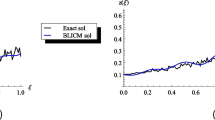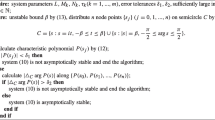Abstract
This paper deals with the implementation techniques of an implicit integrator to achieve fast and accurate analyses of spacecraft dynamics. For this purpose, the pseudospectral method is adopted to directly integrate the second-order system of equations for both the spacecraft dynamics and corresponding state transition matrix. Various implementation techniques are proposed to enhance the numerical efficiency and integration accuracy, which include a moving horizon approach, the decoupled integration of the second-order dynamics for the state transition matrix, and the grid adaptation method. The numerical features of the proposed techniques are investigated through their applications to a spacecraft’s motion around highly eccentric elliptic orbits, and the resultant numerical errors and computing times are compared with those from the Runge-Kutta method to show the relative efficiency and accuracy of the presented methods. In addition, an optimal two-impulse orbit transfer from the Earth to the Moon is analyzed by implementing the proposed methods using a multiple-shooting framework. The results show that the proposed techniques are extremely effective for dynamical problems requiring intensive and accurate time integrations, and can provide much better accuracy and efficiency than the explicit Runge-Kutta integrator.
Similar content being viewed by others
Abbreviations
- A :
-
Jacobian matrix of the force vector
- a m,n :
-
coefficient of the generalized spline interpolation coefficient at the mth time interval
- d EM :
-
distance from the Earth to the Moon
- D :
-
element of the differentiation matrix or parameter to define the orbit direction(= ±1)
- \(\bar D\) :
-
differentiation matrix
- e, e :
-
error or eccentricity, error vector
- f, g :
-
Lagrange coefficients
- \(\tilde f\) :
-
force function vector for the nonlinear algebraic equations
- F :
-
function vector defining the nonlinear algebraic equations
- h :
-
time step size
- h :
-
function vector for nonlinear algebraic equations
- I :
-
element of the integration matrix
- \(\bar I\) :
-
integration matrix
- J :
-
identity matrix
- N :
-
number of nodes for the pseudospectral integrator
- N MS :
-
number of multiple shooting nodes
- N node :
-
number of nodes per time segement
- N seg :
-
number of time segements
- N x :
-
number of the states, x
- p :
-
order of system dynamics
- Q :
-
Jacobian matrix
- r :
-
position vector
- R SOI :
-
sphere of influence of the Moon
- Δ v :
-
delta velocity vector due to the impulsive thrust
- w :
-
quadrature weight
- x, y, z :
-
position of the satellite in the synodic coordinate system
- x :
-
system state vector
- δx :
-
variation in the system state vector
- \(\tilde x\) :
-
unknown variable vector in the nonlinear algebraic equations
- y :
-
system state vector
- α:
-
coefficient of the spline interpolation function or angular position of departure point
- β:
-
factor for the number of statesx or angular position of arrival point
- δ:
-
maximum grid adaptation ratio
- ε:
-
prescribed error tolerance
- \(\tilde \phi\) :
-
generalized spline interpolation function
- ϕ :
-
sub-matrix in the state transition matrix
- σ:
-
mass ratio parameter in the Earth-Moon system
- μ :
-
mass parameter for the Earth and the Moon
- τ:
-
nondimensional time for the pseudospectral method
- τ m :
-
nondimensional time at the mth time interval
- Φ:
-
state transition matrix
- Ω:
-
angular velocity of the Earth-Moon system
- 0:
-
initial condition and initial time
- C :
-
computed solution
- E :
-
exact solution, the Earth’s parameter, or relative error
- f :
-
final states or final time
- N :
-
nominal trajectory
- M :
-
the Moon’s parameters
- RK :
-
Runge-Kutta integrator
- PS :
-
pseudospectral integrator
- r :
-
radial position
- x :
-
gradient with respect to the state variable
- \(\dot x\) :
-
gradient with respect to the state derivative
- v :
-
speed
References
G. Beylkin and K. Sandberg, “ODE solvers using band-limited approximations,” Journal of Computational Physics, vol. 265, pp. 156–171, May 2014. [click]
B. K. Bradley, B. A. Jones, G. Beylkin, K. Sandberg, and P. Axelrad, “Band limited implicit Runge-Kutta integration for Astrodynamics,” Celestial Mechanics and Dynamical Astronomy, vol. 119, no.2, pp. 143–168, May 2014. [click]
X. Bai and J. L. Junkins, “Modified Chebyshev-Picard iteration methods for station-keeping of translunar halo orbits,” Mathematical Problems in Engineering, vol. 2012, Article ID 926158, 2012. [click]
D. Kim, J. L. Junkins, and J. D. Turner, “Multisegment scheme applications to modified Chebyshev Picard iteration method for highly elliptical orbits,” Mathematical Problems in Engineering, vol. 2015, Article ID 290781, 2015. [click]
I. M. Ross and F. Fahroo, “Pseudo-spectral knotting methods for solving optimal control problems,” Journal of Guidance, Control and Dynamics, vol. 27, no. 3, pp. 397–405, May–June 2004. [click]
P. Williams, “A Gauss-Lobatto quadrature method for solving optimal control problems,” Australian and New Zealand Industrial and Applied Mathematics Journal, vol. 47, pp. 101–115, 2006. [click]
F. Fahroo and I. M. Ross, “Costate estimation by a Legendre Pseudo-spectral method,” AIAA Journal of Guidance, Control and Dynamics, vol. 24, no. 2, pp. 270–277, 2001. [click]
D. A. Benson, G. T. Huntington, T. P. Thorvaldsen, and A. V. Rao, “Direct trajectory optimization and costate estimation via an orthogonal collocation method,” Journal of Guidance, Control, and Dynamics, vol. 29, no. 6, pp. 1435–1440, 2006. [click]
X. Xu and P. Huang, “Coordinated control method of space-tethered robot system for tracking optimal trajectory,” International Journal of Control, Automation, and Systems, vol. 13, no. 1, pp.182-193, Feb. 2015. [click]
C.-J. Kim, S. Sung, S. H. Park, S. N. Jung, “Numerical time-scale separation for rotorcraft nonlinear optimal control analyses,” Journal of Guidance, Control, and Dynamics, vol. 37, no. 2, pp. 658–673, 2014. [click]
C.-J. Kim, S. H. Park, S. N. Jung, and S. Sung, “Generalized computational nodes for pseudospectral methods,” International Journal of Aeronautical & Space Science, vol. 15, no. 2, pp. 183–189, 2014. [click]
C.-J. Kim and S. Sung, “Efficient ST techniques for nonlinear optimal control analyses using a pseudospectral framework,” IEEE Transactions on Control System Technology, vol. 23, no. 3, pp. 1110–1116, May 2015. [click]
E. Spedicato and Z. Huang, “Numerical experience with Newton-like methods for nonlinear algebraic systems,” Computing, vol. 58, no. 1, pp. 69–89, March 1997. [click]
D. A. Vallado, Fundamentals of Astrodynamics and Applications, Microcosm Press, pp. 448–470, 2001.
H. D. Curtis, Orbital Mechanics for Engineering Students, Elsevier, pp. 38–52, 2009.
K. Yagasaki, “Computation of low energy Earth-to-Moon transfers with moderate flight time,” Physica D: Nonlinear Phenomena, vol. 197, no. 3-4, pp. 313–331, 2004. [click]
G. T. Huntington, Advancement and Analysis of a Gauss Pseudo-spectral Transcription for Optimal Control Problems, Ph.D. Thesis, Massachusetts Institute of Technology, June 2007.
C. L. Darby, HP–Pseudo-spectral Method for Solving Continuous-Time Nonlinear Optimal Control Problems, Ph. D. Thesis, University of Florida, May 2011.
J. S. Parker, R. L. Anderson, and A. Peterson, “A survey of ballistic transfers to low lunar orbit,” Journal of Guidance, Control, and Dynamics, vol. 36, no. 5, pp. 1501–1511, 2013. [click]
S. S. Fernandes, and S. M. P. Marinho, “Optimal twoimpulse trajectories with moderate flight time for Earth-Moon missions,” Mathematical Problems in Engineering, vol. 2012, Article ID 971983, 2012. [click]
T. S. No, J. M. Lee, G. E. Jeon, D. Lee, and G. Kim “A Study on Earth-Moon Transfer Orbit Design,” International Journal of Aeronautical & Space Science, vol. 13, no. 1, pp. 106–116, 2012. [click]
S. S. Fernandes and C. M. P. Marinho, “Sun influence on two-impulsive Earth-to-Moon transfers,” Journal of Aerospace Engineering, Sciences and Applications, vol. 4, no. 1, pp. 82–91, 2012.
Author information
Authors and Affiliations
Corresponding author
Additional information
Recommended by Associate Editor Wen-Hua Chen under the direction of Editor Fuchun Sun. This work was supported by the National Research Foundation of Korea (NRF) grant funded by the Korean Government (MSIP) (No. 2014M1A3A3A03034589).
Chang-Joo Kim is a Professor of the Department of Aerospace Engineering at Konkuk University, Korea. He received the Ph.D. degree in Aeronautical Engineering from Seoul National University in 1991. His research interests include nonlinear optimal control, helicopter flight mechanics, and helicopter system design.
Dohyeon Lee received his B.S. and M.S. degrees in Aerospace Engineering from University of Ulsan, Ulsan, Korea, in 2011 and 2013, respectively. Presently, he is a Ph.D. student with Department of Aerospace Information Engineering, Konkuk University. His research interests include aircraft flight dynamics, optimal control, and trajectory generation.
Sung Wook Hur received his B.S. and M.S. degrees in Aerospace Information Engineering from Konkuk University, Seoul, Korea, in 2013 and 2015, respectively. Currently, he is a Ph.D. student with Department of Aerospace Information Engineering, Konkuk University. His research interests include nonlinear optimal control, spacecraft trajectory generation, and flight dynamics.
Sangkyung Sung received his B.S. and Ph.D. degrees in Electrical Engineering from Seoul National University, Seoul, Korea, in 1996 and 2003, respectively. Currently, he is an Associate Professor of the Department of Aerospace Information Engineering, Konkuk University. His research interests include inertial sensors, integrated navigation, and application to mechatronics and unmanned systems.
Rights and permissions
About this article
Cite this article
Kim, CJ., Lee, D.H., Hur, S.W. et al. Fast and accurate analyses of spacecraft dynamics using implicit time integration techniques. Int. J. Control Autom. Syst. 14, 524–539 (2016). https://doi.org/10.1007/s12555-014-0486-5
Received:
Revised:
Accepted:
Published:
Issue Date:
DOI: https://doi.org/10.1007/s12555-014-0486-5




